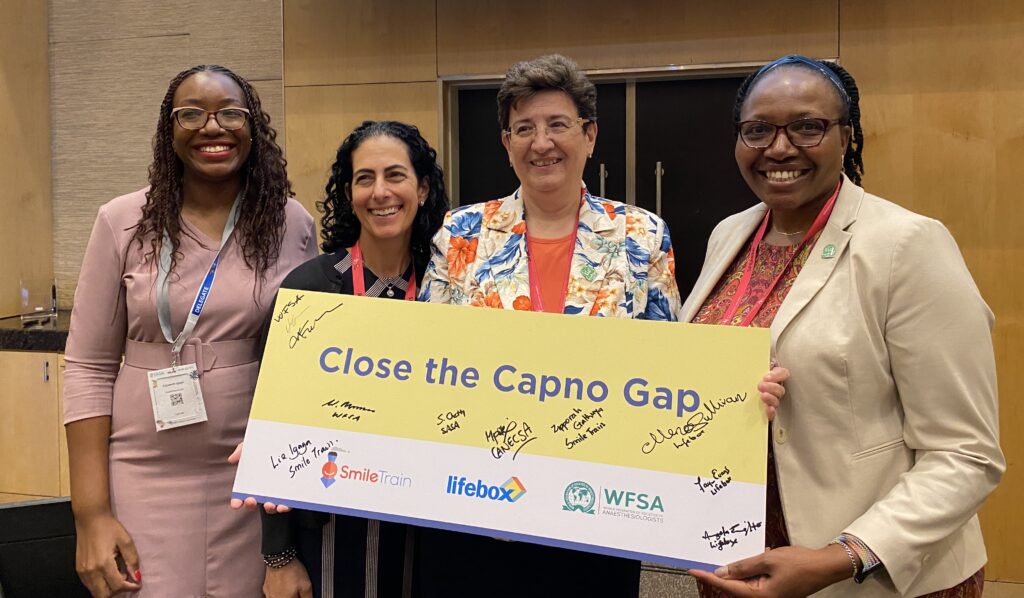A coalition of global health organizations are rooting for rollout of capnography in surgeries to reduce anesthesia-related complications and deaths
Led by Lifebox, Smile Train, the World Federation of Societies of Anaesthesiologists (WFSA), and the South African Society of Anaesthesiologists (SASA) argue that lack of capnography in low-resource settings is putting countless lives at risk.
Capnography is the monitoring of the concentration or partial pressure of carbon dioxide in the respiratory gases. Its main development has been as a monitoring tool for use during anesthesia and intensive care.
‘Including capnography as essential monitoring equipment is a vital step towards enhancing patient safety during surgery,’- Dr Elizabeth Igaga, Director of Programs Safety at Smile Train.
Speaking at the ALL Africa Anaesthesia Congress in Johannesburg South Africa on September 16, these organizations signed an action letter calling for the inclusion of capnography as essential monitoring equipment in anesthesia guidelines.
Ministries of health, professional societies, hospitals, and individual anaesthesiologists from across Africa and beyond participated in the signing of the action letter, marking a unified effort to ensure safer anesthesia practices and significantly improve health outcomes in low-resource settings.
Recommendations of the action letter
The action letter calls on the World Health Organization and national decision-makers to accelerate the adoption of capnography in low-resource settings by; upgrading capnography in the WHO-WFSA International Standards for a Safe Practice of Anesthesia from “recommended” to “highly recommended”, including capnography alongside pulse oximetry in the WHO Surgical Safety Checklist as required equipment for safe surgery, and incorporating capnography as essential in national anesthesia guidelines.
“Including capnography as essential monitoring equipment is a vital step towards enhancing patient safety during surgery,” said Dr Elizabeth Igaga, Director of Programs Safety at Smile Train.
She added; “By advocating for its integration into anesthesia guidelines, we are not only setting a new standard for safer surgical care but also ensuring that every patient, regardless of where they are, has access to life-saving technology.”

Challenge to low income countries
Capnography has been used widely in operating rooms in high-income countries for over three decades.
According to the health sector players, its introduction in the United States in 1991 led to a dramatic decline in anesthesia-related complications and deaths., yet, capnography remains largely unavailable across most low-resource-setting operating rooms, with research showing there is often a 100 per cent gap between the need for capnography and its availability in low-income countries.
A capnograph is taunted as the best tool for detecting a leading cause of anesthesia-related complications and deaths in low-resource settings: the misplacement of the breathing tube supplying oxygen to the patient. Without an oxygen supply, the patient will suffer catastrophic harm in a matter of minutes.
“A capnograph is not just a tool, it’s an essential tool,” noted Dr Tihitena Negussie, Global Clinical Director of Lifebox.
“By integrating capnography into the standard practice of anesthesia worldwide, particularly in low-resource settings where I work, we can prevent countless avoidable complications and save lives. This coalition and the signing of this action letter represent a crucial moment in our collective effort to improve surgical safety,” said Dr Negussie.
The absence of capnography in most low-resource settings has been attributed to its high cost and the scarcity of devices adapted to specific local needs.
In response to this critical shortfall, Smile Train and Lifebox, a global nonprofit that saves lives through safer surgery and anesthesia launched the Smile Train-Lifebox Capnograph, a high-quality, user-friendly, affordable capnograph with sturdy construction and long battery life suited for low-resource settings.
Capnography training package
Working with the World Federation of Anaesthesiologists (WFSA), the Global Capnography Project (GCAP), and other leaders in global anesthesia, the initiative also developed a comprehensive capnography training package for anesthesia providers. 350 Smile Train-Lifebox Capnographs will be distributed this year in Benin, Ethiopia, the Philippines, and Uganda.
“The WFSA is committed to advancing anesthesia safety worldwide, and capnography is a cornerstone of that mission,” said Professor Daniela Filipescu, President of the World Federation of Societies of Anaesthesiologists (WFSA).
Professor Filipescu described the upgrade of capnography’s status in global guidelines as necessary step towards protecting patients and empowering anaesthesiologists to provide the best possible care in any setting.
Professor Sean Chetty, President of the South African Society of Anaesthesiologists noted; “As anaesthesiologists, our primary responsibility is the safety of our patients. The widespread adoption of capnography in low-resource settings will bring us closer to a world where safe anesthesia is a reality for all. Today’s agreement signifies a crucial advancement towards making this life-saving tool available where it is needed most.”
The Society of Anaesthesiologists of South Africa (SASA) is a professional body promoting ethical, innovative, patient-centric anaesthesiology in South Africa, while Smile Train works to empowers local medical professionals with training, funding, and resources to provide free cleft surgery and comprehensive cleft care to children globally.
